News
Paper crisis depriving information oxygen to Lanka’s readers
View(s): By Kapila Bandara
By Kapila Bandara
Relative shortages of the low-grade paper, called newsprint, used by newspaper publishers, and price inflation, have regularly emerged to haunt the print industry.
Back in 1951, such a deficit drew the attention of the UN’s Economic and Social Council, which adopted a resolution, proposing solutions and asking the main consumers to cut down on consumption and paper mills to raise output, UN records show.
The Food and Agriculture Organisation was asked to research raw materials and substitutes.

A credible source of information, newspapers play an important role in promoting and preserving democracy
A study during the period showed newsprint prices had soared and production could not keep pace with demand. In the UK, in 1951, a tonne of newsprint cost US$163.80 from US$84.40 the year before, while in Belgium the price shot up to US$205 from US$112.
In France, publishers were assured of newsprint for a minimum of six pages daily.
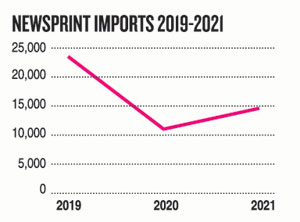 The crisis prompted the French delegate to ECOSOC, Jacques Kayser, to remark that “the victim is democracy.” He explained that the newsprint crisis would worsen in countries “which feel the need most acutely to provide their people with free, plentiful, varied and easily accessible information.”
The crisis prompted the French delegate to ECOSOC, Jacques Kayser, to remark that “the victim is democracy.” He explained that the newsprint crisis would worsen in countries “which feel the need most acutely to provide their people with free, plentiful, varied and easily accessible information.”
His observations echo decades later in Sri Lanka where print publishers are reliving a paper crisis, aggravated by the national economic bankruptcy.
Once again, in paper producing and consuming countries, mills are shutting down, paring production capacity. A dearth of wood and pulp, supply disruptions, high prices, and energy costs are among many factors that have resurfaced, buffeting the publishing industry worldwide. There is also a shift to the use of paper as a replacement for plastic, creating new sources of demand.
Implications of global headwinds for Sri Lanka are immediate.
Sri Lanka’s print landscape is dotted with more than 70 dailies, including seven English dailies, six Sinhala, and eight in Tamil. There are also about 50 weeklies including nine English (as of 2021), 25 in Sinhala (down from 29 in 2020) and nine in Tamil. These are the products of 46 publishers, a study in 2018 by the Media Ownership Monitor shows.
Newspaper publishers have responded to the challenges by devoting less space to local news and even by combining various sections. Pages are trimmed. Distribution is reviewed. The cover prices are revised up to protect margins and to mitigate newsprint costs. Publishing frequency is reduced. The circulation drop accelerates. Newsrooms shrink. But, print remains the funding fuel for new investment in digital technologies.
In recent decades, from the time the first digital ad appeared in 1994 in the world, the shift to digital has eroded print industry ad revenues.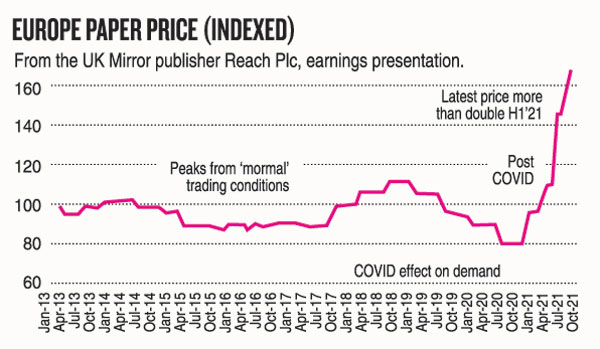
The global demand for newsprint tumbled by 30% in 2020 and then climbed by 7% in 2021. Prices have shot up globally and the effects are now being felt in Sri Lanka, which has dug itself a deep economic hole. Foreign exchange has evaporated and newspaper publishers are clamouring for scarce US dollars to buy newsprint.
Sri Lanka is a net importer of newsprint, which Sri Lanka Customs defines as “uncoated paper’’ used for the printing of newspapers, made of wood fibres and with “surface roughness Parker Print Surf (1 MPa) on each side exceeding 2.5 micrometres (microns), weighing not less than 40 grams per square metre and not more than 65 g/m²”. The print surf method measures the roughness of newsprint and even packaging.
The newsprint HS Code is: 4801.00.00
The newsprint shortage chill is also felt in the US, UK, Australia, India, and elsewhere. From June 2020 to May 2021, the European printing industry has been experiencing “an unprecedented crisis’’ the Brussels-based trade body Intergraf observes. Production capacity has been reduced. Integraf said in March that newsprint prices have soared by up to 80%.
Prices at their highest-ever level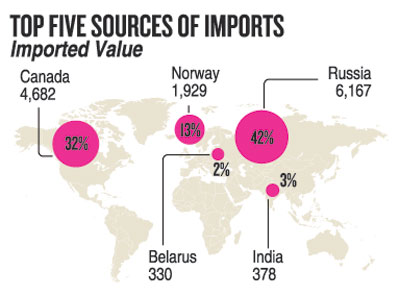
In the US, paper costs have jumped by more than 30% in two years.
Simon Fuller, the chief financial officer at Reach Plc, the UK publisher of Mirror and Daily Express, has noted in July that newsprint prices are “at their highest ever level”.
In India, which is a newsprint producer, imports have dropped sharply for the past five financial years, Parliament was told in August. In 2020-2021, imports nearly halved to 597,766 kilograms. In February, India reduced duty to 5% from 10%.
Unlike the neighbour, Sri Lanka does not have paper mills.
Lal Jayawardene, a director at Wijeya Newspapers Ltd., who has been in the printing and publishing industry for more than 40 years, notes the challenges related to newsprint costs and purchases and also worries about the long-term consequences for readers.
“Two years ago, we were buying at US$500 a metric tonne. Now, the price has increased to US$1,100 MT. Our import quantities are large. At one time, we import 500 MT and a minimum 250 MT, because consumption is very high. Banks are unable to allocate US dollars of about US$300,000 at one time for imports. The commercial banks suggest imports of below US$50,000. It takes two to three weeks to open letters of credit, or to make the telegraphic transfer payment. So, there is a severe shortage of newsprint.”
The cost of production is also increasing, he notes.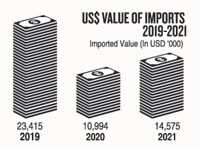
“Given the shortage of paper, we are compelled to cut pages. This deprives some sections of the readers, as some reading material has to be removed especially on art, youth, and lifestyles,’’ Mr Jayawardene said.
Cover prices have been increased as well.
“The Sunday Times increased the price. About seven months ago, it was Rs 80. But, it has almost doubled to Rs 150, because the paper consumption is high. It is a paper with many sections,” he said.
“Because of the current economic conditions, trading has declined. To print a copy we spend Rs 200 to Rs 250 and we sell below that. The rest [of the cost] we recover from advertising income. Advertising income has declined because of the economic contraction.”
He said the Government is focused on preserving foreign exchange and spending what it has on essentials for human life, such as fuel, food, and medicines. “We can’t disagree with that.”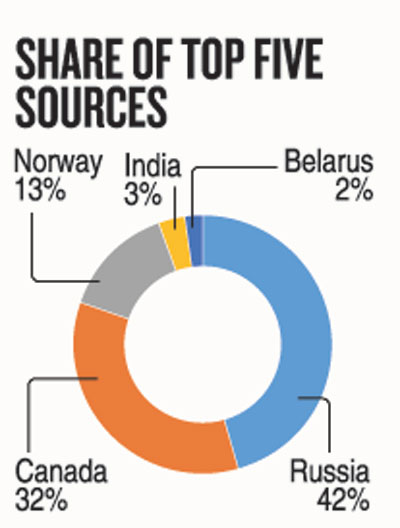
The most recent Gazette notice suspended imports of printing machinery and parts, he noted.
“Paper prices started to increase around January. From last December, there was this issue of lack of forex for imports. Over nine to 10 months this issue has lingered.
“Earlier, we were importing from Malaysia, South Korea, Indonesia, and Japan. The demand went up in that region also. Then, we turned to Russia and Canada for imports.
“Seven to eight years ago, the paper supply was from mainly Asia. It was easier because the procurement times are shorter. Now, paper supplies come from Russia, Canada, and Scandinavian countries. These countries maintain commercial forests. But now, we can’t open LCs for Russia, because of the international embargoes.
“We were importing 25,000 MT to 30,000MT of paper a year. Over the past six months, we could only import 3,000 MT. Fortunately, we have maintained a buffer stock that will be enough for about four months.”
Mr Jayawardene said consumption had fallen drastically because of disruptions such as lockdowns and the publisher was unable to supply the market. There is also the fuel shortage.
“Because consumption fell drastically, we can manage up to October or November. After that, there will be no paper to print.”
Distribution costs have increased due to disruptions.
“This has affected the 1,200 agents we have across the country. They have 20-150 sub sales points in their areas. They do the deliveries by motorbike and due to the high fuel costs and scarcity they were badly hit and some of them stopped deliveries in their areas.”
Newspapers are considered to be a low-cost channel of information for the masses, he said.
And he believes the newsprint shortage will affect the people’s democratic right to information.
“The alternative, social media such as Facebook and WhatsApp is mainly fabricated and non-reliable information. It is irresponsible dissemination of news. We are really worried that the reading habit will drastically decline because of this situation.”
Data from the Ceylon Chamber of Commerce, citing the International Trade Center, show that newsprint imports in 2019 were worth US$23.41 million.
And in 2020, imports dropped sharply to US$10.99m. In 2021, imports rebounded to US$14.57m.
Russia, Canada, Norway, India, and Belarus are the top five import sources. Russia accounted for the largest share at 42% and imports were worth US$6.17m.
Imports from Canada were worth US$4.68m and accounted for a 32% share. Imports from Norway amounted to US$1.92m and made up 13%.
From India, imports were valued at US$378,000, making up 3%, and paper from Belarus was worth US$330,000, accounting for 2%.
No import control
Chamber economist Jayani Ratnayake said newsprint had not been under import controls since April 2020. “The reduction in imports could also be a result of the (coronavirus disease) pandemic where digital newspapers were preferred over printed editions.”
She said there is no reliable data on the number of private importers of newsprint.
“Sri Lanka Customs does not provide micro-level data on individual importers.’’
Two emailed requests to Anusha Palpita, the secretary of the Ministry of Mass Media, following a call, went unanswered.
The office of Sri Lanka Press Council chairman, Mahinda Pathirana, when contacted, could not answer an inquiry in English about his availability and later calls were not answered.
Challenges for Sinhala news publishers have multiplied over the past few years.
Siri Ranasinghe, the editor in chief of Lankadeepa, said publishers are facing a difficult time as a result of “very very high’’ prices of newsprint.
“There is also the US dollar scarcity.’’
He said the daily Lankadeepa reduced the number of pages to 10 from 24. “It was reduced gradually. We print 12 pages on Mondays and Thursdays.”
Lankadeepa publishes on Saturdays, but other newspapers do not publish on Saturday. Instead, there is the Sunday edition, he said.
Regardless of the electronic media, people need to read print, he said.
“Only a limited amount of national news and current affairs, as well as related articles and analysis, is published. This has meant that we are sharing less information with people. This limits the people’s democratic right to know.”
He noted that distribution to the provinces is curtailed because of fuel scarcity.
“We have raised this newsprint shortage issue with the Ministry of Mass Media, but the Government also has to deal with more critical challenges such as food, medicine, and fertiliser imports.”
Lankadeepa, published by Wijeya Newspapers, has a 5.3% readership share, based on a study by the Media Ownership Monitor.
S. Srikajan, the editor of Virakesari, said the newsprint shortage led to the reduction in the number of pages to 16 from 24. “We reduced about three months ago.” He said the cover price was also increased to Rs 50 from Rs 30.
Virakesari is the oldest Tamil newspaper in Sri Lanka. It is published by Express Newspapers (Ceylon) Ltd. It also publishes the Daily Express in English as well as Kalaikesari, among other titles.
Information is the lifeblood of a democracy, and the mass media, which is the connective tissue of a democracy, is the main carrier.
If the newsprint shortage in Sri Lanka is not addressed for the long term, published information could become a luxury that could only be afforded by those who can pay for it.
The best way to say that you found the home of your dreams is by finding it on Hitad.lk. We have listings for apartments for sale or rent in Sri Lanka, no matter what locale you're looking for! Whether you live in Colombo, Galle, Kandy, Matara, Jaffna and more - we've got them all!

